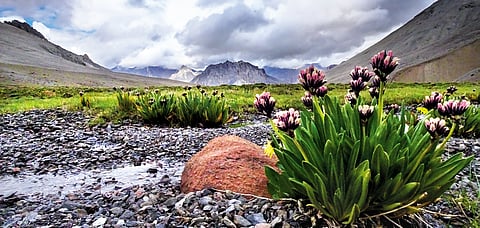
- Destinations
- Experiences
- Stay
- What's new
- Editor’s Picks
- Responsible Tourism
- CampaignsCampaigns
- Subscribe

I rotate the map in every possible angle, trying to make sense of it. It appears like a government policy, in utter mismatch with ground realities. In a desperate attempt, I try to vividly replay every word of the old man, who had last lent me directions at Kanji, Ladakh. Pointing towards east, in a deep rhythmic voice, he had said, &ldquoShielakong, oh, chaar ghanta&rdquo (Shielakong, oh,four hours).
It&rsquos been two days since and I am yet to reach Shielakong, the third overnight campsite of the 10-day long Lamayuru trek. I have been lost before it comes with the territory but this is by far, my personal best. Having crossed muddy torrents over a dozen times and retraced my steps from countless dead ends, the spellbinding Ladakhi scenery is beginning to wane on me. Taking a deep breath, I rally on for one last time. The decision was made&mdashanother dead end, and I am heading back to Kanji.
It&rsquos a long and steep climb along narrow tracks, abruptly opening onto a hidden treasure. I instantly go down on my knees, bowing to don&rsquot know what. All I know is that this is a willing submission. I have bowed before. In temples, or to elders. But it&rsquos my first time bowing to nature.
I have travelled and seen more than most been surprised, overjoyed, and blown away. But never overpowered. Smashed to fine dust, my ego blows away with the gentle breeze. It&rsquos astounding, the effect nature can have over you.
I collect myself, the soreness in my legs, back and shoulders has vanished. Maybe the laws of nature work differently here. Or maybe, this is just a dream. I pinch myself, it&rsquos not a dream.
Rolling hills, like the soft rising mounts of a palm surround me from three sides. The fingers gently tapering downwards in offering, open up to a spread of jagged mountain peaks that stare back at eye level. Cradled in the central depression, lies a lavish flowering meadow, in full bloom. It is a riot of colours wherever I glance. A silent clear brook trickles downhill erupting and disappearing at will under the gravelly ground, it criss-crosses the entire meadow-like a well laid out irrigation system.
This is not what Ladakh is supposed to look like. It&rsquos a parched barren high-altitude desert, with a two tone landscape brown and grey. Forget Ladakh, nothing at 5,000 metres is supposed to look like this. But you can&rsquot argue with nature.
An incredible variety of wildflowers erupt effortlessly from under the glacier moraine. The entire valley is aglow in intense shades of blue, yellow, pink, white and violet. However, the heavy weight of this floral paradise, both in prevalence and allure, is the Mule&rsquos Ear Sunflower (Wyethia amplexicaulis). Brilliant yellow with frosty leaves, this perky miniature sunflower paints the meadow in a golden hue.
The valley gradually rises to an enormous glacier, that protectively shields the valley from three sides. There is only one way ahead, and it is backwards to Kanji. But I decide to revel in beauty for a bit longer and set up camp in my own private, &lsquoValley of Flowers&rsquo. Heading back two days later, I feel like an ancient explorer who has chanced upon this secret place, that no one else know about.
